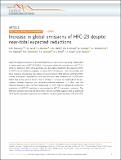| dc.contributor.author | Prinn, Ronald G. | |
| dc.date.accessioned | 2020-04-16T14:02:27Z | |
| dc.date.available | 2020-04-16T14:02:27Z | |
| dc.date.issued | 2020-01 | |
| dc.identifier.issn | 2041-1723 | |
| dc.identifier.uri | https://hdl.handle.net/1721.1/124686 | |
| dc.description.abstract | Under the Kigali Amendment to the Montreal Protocol, new controls are being implemented to reduce emissions of HFC-23 (CHF3), a by-product during the manufacture of HCFC-22 (CHClF2). Starting in 2015, China and India, who dominate global HCFC-22 production (75% in 2017), set out ambitious programs to reduce HFC-23 emissions. Here, we estimate that these measures should have seen global emissions drop by 87% between 2014 and 2017. Instead, atmospheric observations show that emissions have increased and in 2018 were higher than at any point in history (15.9 ±0.9Ggyr−1). Given the magnitude of the discrepancy between expected and observation-inferred emissions, it is likely that the reported reductions have not fully materialized or there may be substantial unreported production of HCFC-22, resulting in unaccounted-for HFC-23 by-product emissions. The difference between reported and observation-inferred estimates suggests that an additional ~309 Tg CO 2-equivalent emissions were added to the atmosphere between 2015 and 2017. ©2020 | en_US |
| dc.language.iso | en | |
| dc.publisher | Springer Science and Business Media LLC | en_US |
| dc.relation.isversionof | 10.1038/s41467-019-13899-4 | en_US |
| dc.rights | Creative Commons Attribution 4.0 International license | en_US |
| dc.rights.uri | https://creativecommons.org/licenses/by/4.0/ | en_US |
| dc.source | Nature | en_US |
| dc.title | Increase in global emissions of HFC-23 despite near-total expected reductions | en_US |
| dc.type | Article | en_US |
| dc.identifier.citation | Stanley, K.M., et al., "Increase in global emissions of HFC-23 despite near-total expected reductions." Nature communications 11, 1 (January 2020): no. 397 doi 10.1038/s41467-019-13899-4 ©2020 Author(s) | en_US |
| dc.contributor.department | Massachusetts Institute of Technology. Center for Global Change Science | en_US |
| dc.relation.journal | Nature communications | en_US |
| dc.eprint.version | Final published version | en_US |
| dc.type.uri | http://purl.org/eprint/type/JournalArticle | en_US |
| eprint.status | http://purl.org/eprint/status/PeerReviewed | en_US |
| dc.date.updated | 2020-04-07T12:10:32Z | |
| dspace.orderedauthors | Stanley, K. M. ; Say, D. ; Mühle, J. ; Harth, C. M. ; Krummel, P. B. ; Young, D. ; O’Doherty, S. J. ; Salameh, P. K. ; Simmonds, P. G. ; Weiss, R. F. ; Prinn, Ronald G. ; Fraser, P. J. | en_US |
| dspace.date.submission | 2020-04-07T12:10:34Z | |
| mit.journal.volume | 11 | en_US |
| mit.journal.issue | 1 | en_US |
| mit.license | PUBLISHER_CC | |
| mit.metadata.status | Complete | |
